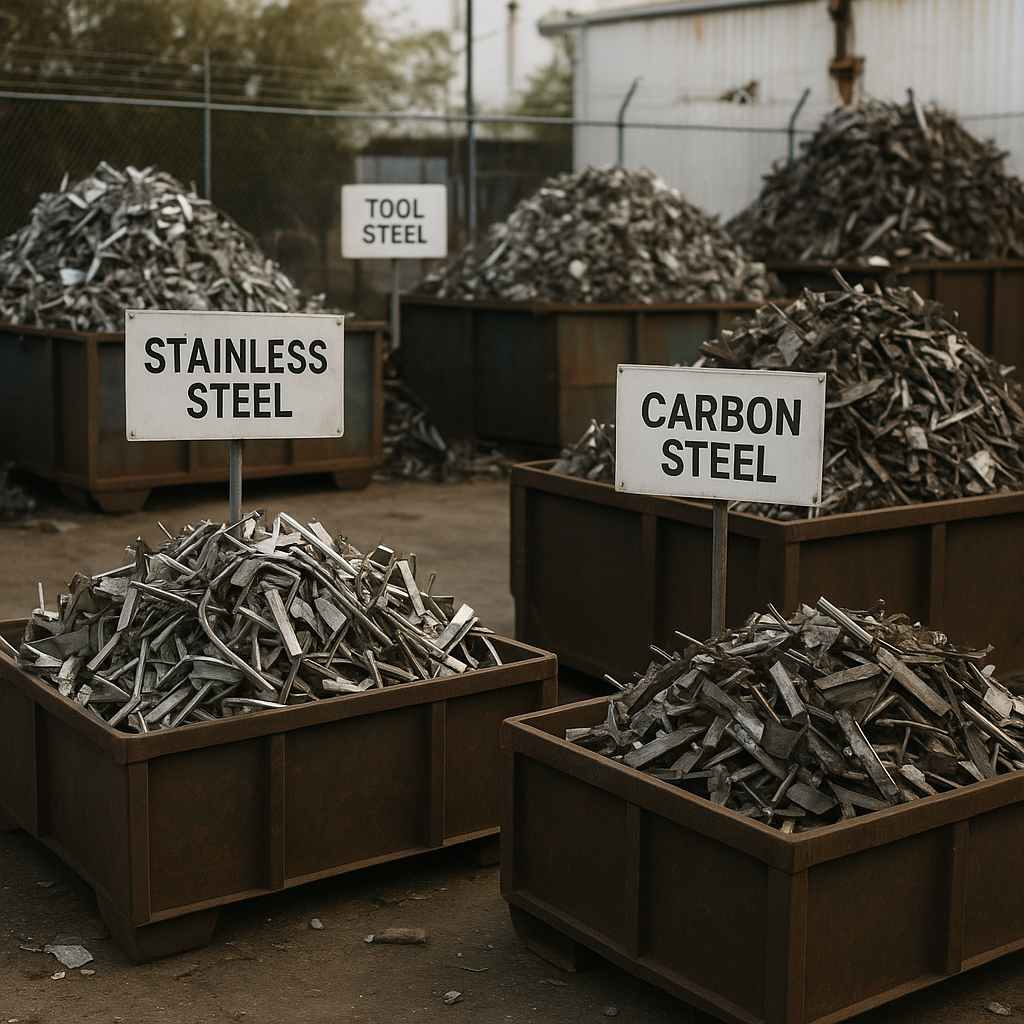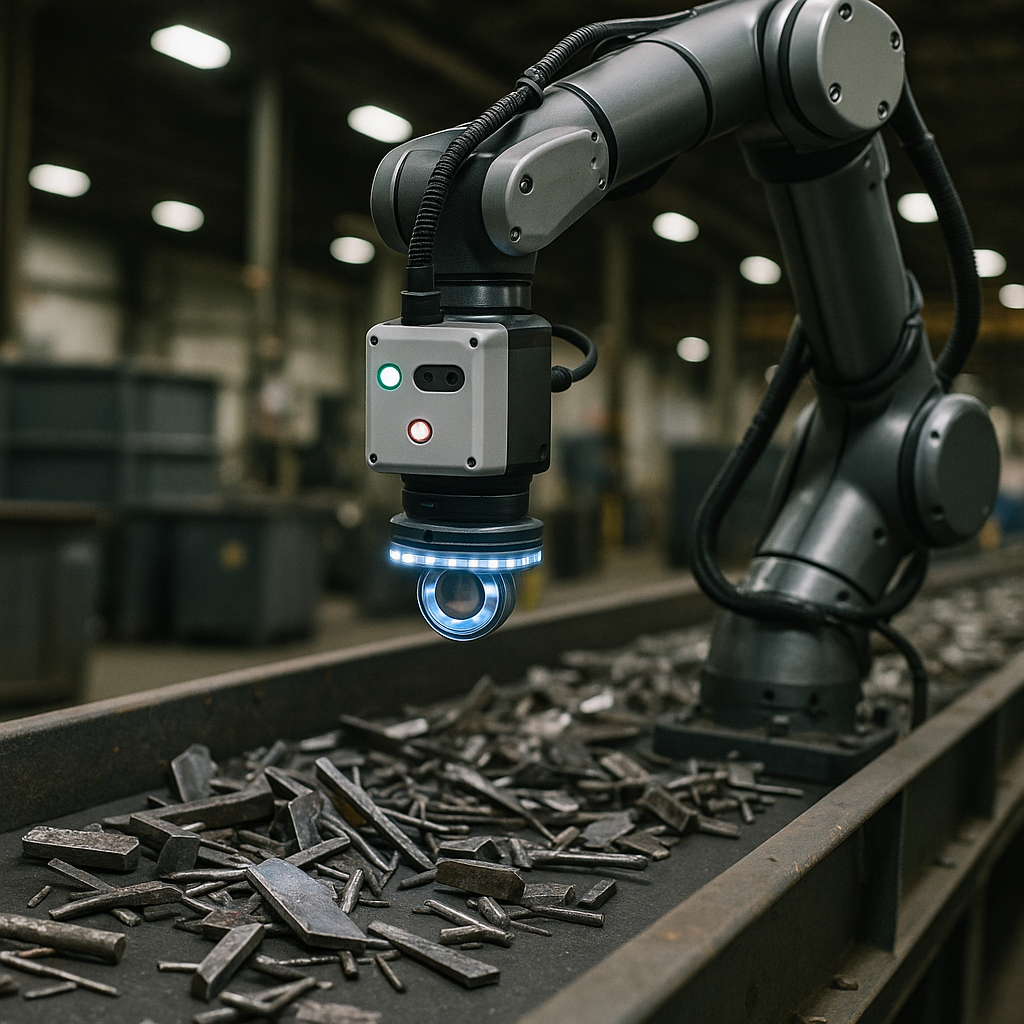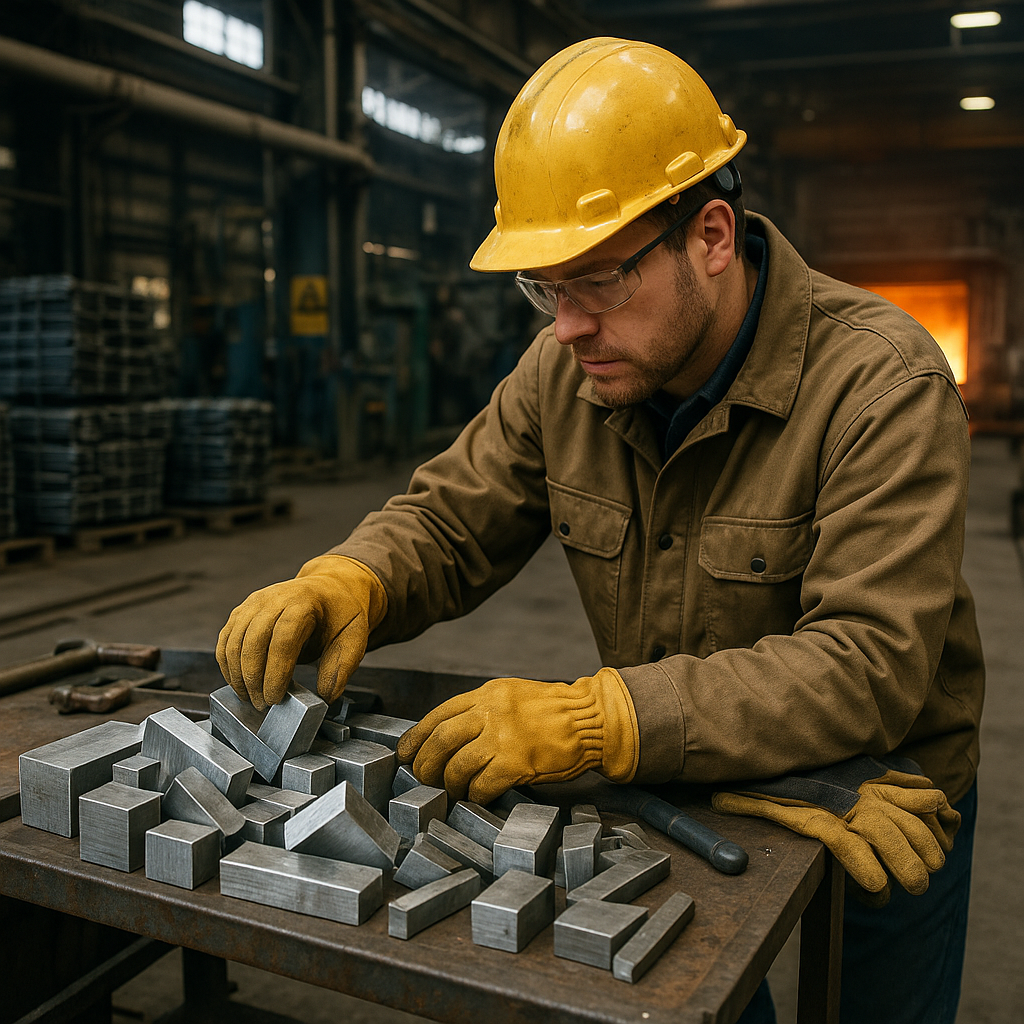5901 Botham Jean Blvd, Dallas, TX 75215
What Are Steel Scrap Grading Systems?
May 28, 2025Steel scrap grading systems provide a standardized framework for classifying metal waste based on quality, composition, and origin. These classification methods serve as a universal language in the recycling industry, allowing stakeholders to assess material value quickly and accurately.
The steel recycling process requires precise categorization to maintain efficiency and quality standards. Without proper grading, recyclers would struggle to determine the appropriate processing methods for different types of scrap, and manufacturers might receive inconsistent raw materials, compromising their final products.
The economic impact of steel scrap grading extends throughout the supply chain. Proper classification creates price transparency in the market and ensures fair compensation for materials. In 2023, the difference between premium grade scrap and lower quality varieties often exceeded $100 per ton. This substantial pricing gap highlights why accurate grading is crucial for businesses operating with thin margins in the competitive metals industry.
What are the Main Categories of Steel Scrap?

Steel scrap is categorized into two main types based on its source and condition, aiding recyclers, steel mills, and manufacturers in selecting appropriate processing methods and applications.
Obsolete Scrap
Obsolete scrap originates from products that have reached the end of their useful life, having served their purpose in consumer or industrial applications.
Sources include:
- Automotive scrap – Non-operational vehicles such as cars, trucks, and heavy machinery
- Demolition scrap – Steel from demolished buildings, bridges, and structures
- Household appliances – Discarded items like refrigerators and washing machines
Obsolete scrap generally contains more impurities and contaminants, affecting its recyclability and value due to wear and exposure over time.
Prompt Scrap
Generated during manufacturing processes before steel becomes part of a finished product, prompt scrap is cleaner and of higher quality than obsolete scrap.
Common sources include:
- New production scrap – Off-cuts, trimmings, and rejected materials from steel manufacturing
- Industrial byproducts – Steel waste from fabrication or shaping operations
- End-of-line scrap – Materials discarded during steel product processing
Valued for its purity and known composition, prompt scrap is easier to recycle and more valuable per ton.
Common Steel Scrap Grades
Steel scrap is further classified into specific grades based on quality, composition, and physical characteristics:
Heavy Melting Steel (HMS)
HMS includes thick, heavy steel pieces requiring torch cutting before processing.
- #1 HMS – High-quality, thick steel with minimal contaminants, often from structures or heavy machinery
- #2 HMS – Lower quality with some rust, dirt, or non-steel materials present
Shredded Scrap
This includes steel processed through a shredder to create smaller, uniform pieces, aiding transport and melting.
Typically derived from automobiles and appliances after non-ferrous materials are removed, its consistent size benefits electric arc furnace operations.
Clean Scrap
Refers to steel free from impurities like dirt, oil, or other metals, available from both obsolete and prompt sources.
A notable type is clean busheling, clean, uncoated sheet clippings and stampings from manufacturing, commanding premium prices in recycling markets.
Understanding these categories helps recyclers sort and process steel scrap effectively, maximizing value and meeting quality requirements for intended applications. This classification system supports efficient recycling, contributing to the circular economy in steel production.
How Do Automated Steel Scrap Grading Systems Work?

Automated steel scrap grading systems use advanced technologies to transform the traditionally manual and error-prone process of scrap classification into a precise, efficient operation. These systems rely on sensors, artificial intelligence, and mechanical components working together.
At their core, automated grading systems employ computer vision technology with high-resolution cameras that capture detailed images of scrap metals as they move along conveyors. These images provide the raw data needed for the AI to make accurate classifications.
The system processes these images through deep learning algorithms trained on thousands of examples of different scrap types. This training enables the AI to recognize visual patterns distinguishing various grades of steel scrap, regardless of their orientation or condition.
Key Components of Automated Grading Systems
Machine vision serves as the eyes of the system. Multiple cameras positioned at strategic angles capture images of scrap materials from different viewpoints. This comprehensive visual data allows the system to analyze the size, shape, and surface characteristics of each piece.
Alongside visual data, many systems incorporate spectroscopic analysis methods. Laser-induced breakdown spectroscopy (LIBS) and X-ray fluorescence (XRF) technologies analyze the elemental composition of scrap pieces. These technologies can detect specific elements to determine alloy composition with high precision.
Deep neural networks process all this data simultaneously. The AI compares the incoming information against its trained models to classify each piece of scrap according to predetermined categories. The system can identify various characteristics including thickness (from <3mm to >6mm), presence of galvanization, paint, or oil, and contaminants.
The Grading Process in Action
When scrap steel enters the facility, it typically passes through an initial sorting phase. Conveyor systems move the material past the various sensors while maintaining separation between pieces for optimal analysis.
As materials pass through the scanning area, the AI processes the data in real-time, making split-second decisions about classification. Modern systems can analyze hundreds of pieces per minute with accuracy rates exceeding 90%.
Once classified, mechanical sorting systems—often robotic arms guided by the AI—direct the scrap to appropriate bins or processing streams. This automation eliminates the need for manual handling, which is both dangerous and less efficient.
Advantages Over Manual Grading
Automated systems offer remarkable consistency in grading. Unlike human inspectors, AI doesn’t experience fatigue or distraction, maintaining the same level of accuracy throughout operations.
Safety improves dramatically as workers no longer need to physically handle potentially hazardous materials. Automated systems can identify and flag dangerous items like pressurized containers, ammunition, or other explosive materials.
The speed of automated processing far exceeds what human sorters can achieve. A facility equipped with AI grading can process significantly higher volumes of scrap while maintaining quality standards.
Perhaps most importantly, these systems reduce disputes about grading accuracy. The objective nature of machine-based grading eliminates questions of fairness that often arise in traditional visual inspection methods.
Automated systems also continuously learn and improve. Each piece of scrap processed adds to the system’s database, allowing the AI to refine its classification abilities over time through ongoing machine learning processes.
Implementation Challenges and Solutions
Despite their advantages, implementing automated grading systems requires significant initial investment. However, the long-term return through increased throughput, higher recovery rates, and reduced labor costs makes them economically viable for many operations.
Training the AI requires extensive datasets of properly classified scrap. Companies developing these systems often create their own datasets by documenting thousands of scrap samples to train their deep learning models effectively.
Integration with existing recycling infrastructure can present challenges. Many facilities retrofit automated grading systems into their current operations, requiring careful planning and sometimes process redesign.
As technology advances, these systems are becoming more accessible and adaptable, allowing even smaller recycling operations to benefit from automated grading. The future of scrap steel recycling clearly points toward increased automation and AI integration, promising greater efficiency and sustainability in metal recovery operations.
What are the Benefits of Effective Steel Scrap Grading?
Enhanced Quality Control
Effective steel scrap grading serves as a crucial quality control mechanism in steel production. When scrap is accurately graded, manufacturers can identify and eliminate contaminants that might compromise the integrity of the final product. This meticulous sorting ensures that harmful materials like plastics, rubber, or incompatible metals are removed before processing.
Steel mills can select the most suitable inputs for specific end products when scrap is precisely graded. For high-quality engineering steel, processors can use premium grades with minimal residual elements. This precision in material selection leads to more consistent and reliable steel production outcomes.
The quality benefits extend throughout the supply chain. Steel producers gain confidence in their raw materials, while end-users receive products with predictable performance characteristics. This reliability is particularly crucial in industries with stringent safety requirements like automotive manufacturing and construction.
Improved Processing Efficiency
Different grades of steel scrap require specific processing methods for optimal results. Proper grading allows recyclers to route materials through the most appropriate processing channels based on composition and quality. This targeted approach reduces unnecessary processing steps and maximizes resource utilization.
Energy consumption decreases significantly when scrap is properly graded. Lower-quality scrap typically requires more intensive processing and purification, consuming additional energy. By directing materials to the correct processing streams, recyclers minimize energy waste and boost operational efficiency.
Production speeds also benefit from effective grading practices. With properly categorized inputs, manufacturers experience fewer production interruptions and quality issues. This streamlining results in faster throughput times and more consistent output.
Substantial Environmental Benefits
Proper steel scrap grading plays a crucial role in reducing the environmental footprint of the steel industry. When scrap is effectively graded, it can more efficiently replace virgin iron ore in steel production. This substitution conserves natural resources and reduces the ecological impact of mining operations.
Steel recycling through properly graded scrap delivers impressive carbon emission reductions. Producing steel from scrap using electric arc furnaces requires significantly less energy than manufacturing from raw materials. Research shows that recycling steel saves approximately 1.5 kg of CO2 emissions per kilogram of scrap recycled.
Water conservation is another environmental advantage of efficient steel scrap grading. The processing of properly graded scrap uses substantially less water than primary steel production methods. This conservation becomes increasingly important as global water scarcity concerns grow.
Economic Value and Market Pricing
The market value of steel scrap directly correlates with its grade. Higher-quality scrap commands premium prices due to its greater utility in producing high-grade steel products. Proper grading ensures that sellers receive appropriate compensation for quality materials while buyers pay fair market value.
Steel scrap grades influence pricing throughout the supply chain. Clean, well-sorted scrap typically sells for 15-30% more than mixed or contaminated materials. This price differential creates economic incentives for improved sorting and grading practices across the industry.
Cost savings extend beyond raw material prices. When manufacturers use properly graded scrap, they experience fewer production issues and quality defects. These operational efficiencies translate into tangible financial benefits that strengthen the economic case for meticulous grading standards.
Supporting Circular Economy Principles
Effective steel scrap grading forms a cornerstone of circular economy principles in the metals industry. By sorting and classifying materials according to their properties, the steel industry ensures that resources remain in productive use for longer periods. This approach minimizes waste and maximizes the value extracted from existing materials.
Grading systems facilitate closed-loop recycling where materials maintain their inherent properties across multiple life cycles. Steel recycled through proper grading can maintain its quality through numerous recycling cycles. This persistence of material value is fundamental to sustainable resource management.
The steel industry demonstrates how grading and classification systems can support broader sustainability goals. With recovery rates exceeding 85% for many steel products, properly graded scrap provides a template for other industries seeking to implement circular economy practices.
Conclusion: The Future of Steel Scrap Grading Systems

Steel scrap grading systems are a cornerstone of modern recycling operations, enhancing efficiency and sustainability in steel production globally. The market for intelligent grading systems is rapidly expanding, with projections indicating growth from $2 billion in 2024 to approximately $3.5 billion by 2030. This growth underscores the essential role these systems play in producing high-quality recycled steel while reducing environmental impact.
Looking ahead, artificial intelligence and machine learning will extend the capabilities of these grading systems. These technologies allow for more accurate identification of different steel grades with minimal human intervention, maximizing material recovery value and ensuring recycled steel meets increasingly stringent quality standards. For the recycling industry, the circular economy, and our planet, these advancements are a significant step forward in sustainable resource management. For your steel recycling needs, contact Okon Recycling at 214-717-4083.
